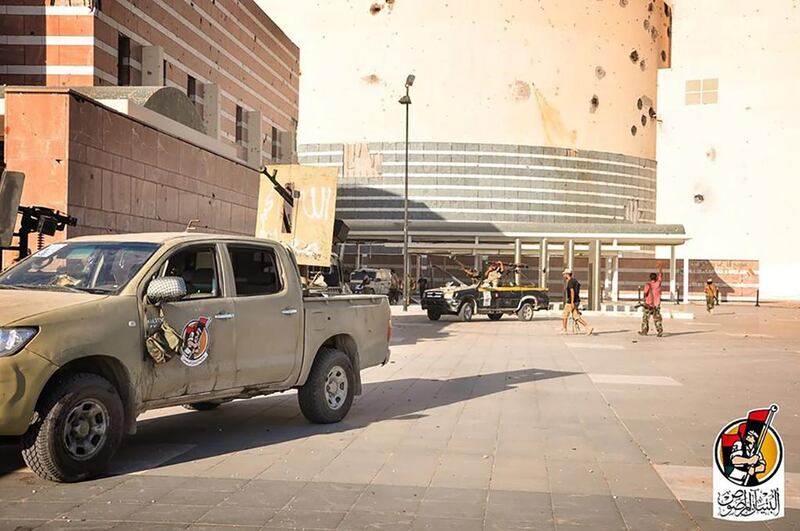PARIS // The capture of the gigantic Ouagadougou Conference Centre in Sirte has dealt a critical blow against ISIL in Libya, albeit at a high cost to Libyan forces.
For the past year, ISIL’s black flag had been draped over the domed structure, which served as the headquarters of the extremist group’s self-declared Libya caliphate that once stretched 200 kilometres along the coast.
The complex, home to a vast central auditorium, was built by former dictator Muammar Qaddafi to boost his dream of being seen as a leader for all Africans. Its concrete walls proved impervious to artillery for weeks, frustrating government troops, while ISIL snipers on its rooftops kept up a murderous fire.
The convention centre’s capture by forces of the UN-backed Government of National Accord (GNA) has robbed ISIL of its key stronghold in Sirte, a coastal town 450 kilometres east of Tripoli.
Photographs from Sirte on Thursday showed the black flag gone and government fighters outside the building holding red, black and green Libyan flags. The sand-coloured structure is now pockmarked with blackened shell holes and most of its windows are shattered.
The Pentagon estimated that 350 ISIL fighters remained in Sirte on Wednesday, with GNA commanders saying the bulk of them were in residential areas close to the coast. It is likely that the remaining ISIL units, having lost their stronghold, will be mopped up in the coming days and weeks. Less clear is how many of Libya’s ISIL fighters, estimated to number 6,000 by Washington earlier this year, remain in guerrilla formations elsewhere in the country. Over the past 18 months ISIL operating in Tripoli have launched an attack on Miteega prison, trying to free jailed comrades, and in January last year killed 9 people in an attack on the city centre Corinthia hotel.
Sixteen government fighters were killed and 11 wounded in Wednesday’s battle, adding to a toll of more than 300 dead and 1,500 wounded in a campaign that began on May 12 against the militant group. The GNA also lost a fighter jet over the town, which ISIL claimed to have shot down. The GNA, however, insisted that the crash was accidental.
The success of the Sirte campaign adds to losses suffered by ISIL in Iraq and Syria and follows the same model, with US air strikes and special forces supporting local ground troops.
Lt Gen Sean MacFarland, American joint task force commander for Operation Inherent Resolve which targets ISIL in Iraq and Syria, told a Pentagon press conference on Wednesday that “the enemy [ISIL] is in retreat on all fronts”.
Unlike Syria and Iraq, where the US-led coalition has waged a bombing campaign for nearly two years, American air power came late to Libya’s war against ISIL. Only on August 1, after appeals by the GNA, did American jets begin hitting militant targets in Sirte.
Drones and US Marine Corps Harrier jets based on the USS Wasp, an amphibious assault ship in the Mediterranean, have carried out 28 strikes on ISIL tanks, vehicles and fighting positions in Sirte, according to the Pentagon.
The battle against ISIL is one of the few things Libya’s divided factions agree on. The group lost its western base in Libya, at Sabratha, in February following attacks by US planes and local militias. Meanwhile, an ISIL enclave in the eastern city of Benghazi shrank this week after gains made by Gen Khalifa Haftar, commander of the army of the Tobruk-based parliament, which has yet to recognise the GNA.
Gen McFarland cautioned that ISIL may now “morph” into a guerrilla group in Libya, but said defeat in Sirte would see its days as an organisation capable of holding territory come to an end.
From its inception, ISIL differentiated itself from other militant groups by insisting it could set up self-declared caliphates immediately, rather than operating as a clandestine organisation hoping to win territory in the future. Its inability to hold territory marks not just a military defeat, but a more punishing psychological blow, striking at the central aim of its existence.
ISIL first moved into Libya in the summer of 2014, headed by Libyan fighters who had gained experience in Syria’s civil war.
But its extremist ideology failed to gain traction among Libyans, for whom tribal affiliations are paramount. Those tribal loyalties are the source of Libya’s own factional conflicts, but they have proved resistant to ISIL’s appeal. The bulk of its combatants, estimated by the Pentagon at 6,000 earlier this year, are foreign volunteers, many from Tunisia, Egypt and Sub-Saharan Africa.
States around the Mediterranean are hoping Libya not only crushes ISIL at Sirte and Benghazi, but can tackle its guerrilla units elsewhere in the country.
France’s defence minister Jean-Yves Le Drian warned earlier this year that ISIL could use its Libya base to smuggle terrorists to Europe. Neighbouring Egypt says militants smuggle weapons from Libya to insurgents in the Sinai. Tunisia, on Libya’s western border, has said ISIL suicide attackers who killed foreign tourists last year at the capital’s Bardo museum and Sousse holiday resort were trained at Sabratha. Yet the country’s chaos, with civil war continuing between the two rival governments, leaves question marks over Libya’s ability to find ISIL units operating under cover.
foreign.desk@thenational.ae





